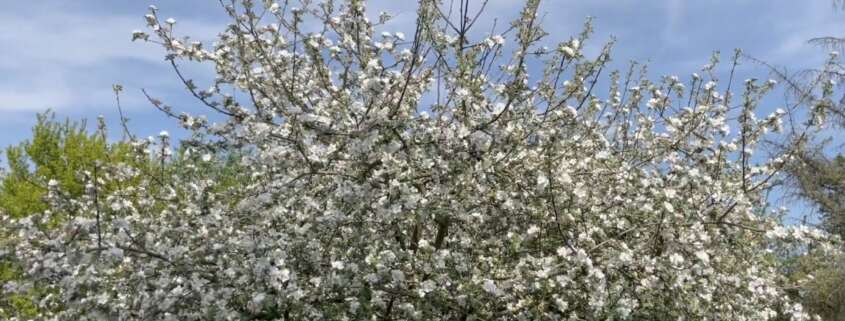Planting pruning
For purists, planting a fruit tree with bare roots is the best, and it is often a guarantee of quality for the plant.
But hey, everyone has their own opinion on the subject…
The planting pruning of a bare root fruit tree can be severe… Or light… The technicians found this a point of conflict!
Planting size.👨🏻🌾
Well, we should already know what the bare root corresponds to?
A bare root plant refers to a plant that is sold and transplanted without its pot, with the roots exposed. It is extracted from the ground and its roots are cleared of soil before being delivered and sold.
This is often done to facilitate transportation and handling of plants, reduce shipping costs, and allow gardeners to purchase fruit trees at times when they are not in the active growing season.
When you purchase a bare root plant, it is important to replant it quickly to minimize its stress and ensure a successful recovery. Before planting, the roots should often be soaked in water to rehydrate them. This is common for fruit trees, shrubs, rose bushes and other types of plants.
Where do bare roots come from?🌳
Techniques for growing and selling bare-root plants date back many years and have evolved according to the needs of gardeners, growers and markets.Nurseries, where plants for transplanting are grown and sold, have a long history. The practice of growing plants in nurseries dates back to ancient times, when farmers and gardeners began producing plants for the needs of agriculture and landscaping.Bare root plants are easier to transport than those in a “ball” or “pot”, because they are lighter and take up less space. An important argument with the advent of modern means of transport, when plants often had to be shipped long distances.Another advantage is that growing and selling bare-root plants can reduce production costs compared to pot-grown plants because they require fewer resources in terms of substrate, water and space. These are less expensive plants.
How do we organize ourselves? 😜
Bare root plants can be sold and transplanted during the dormant period, when the plant is not actively growing (fall and winter in our country).Some plants adapt better to transplanting when rooted bare, as this helps minimize transplant shock by removing the potting soil surrounding the roots. Root development is then faster after planting.There are therefore many advantages to installing these bare root plants provided that certain rules are respected…Planting pruning depends on the type of plant you have and the condition of its roots. Before pruning, carefully examine the roots of the plant. Remove any damaged, diseased or dead roots.If the roots seem too long, you can trim them back to encourage denser root development. Moderate pruning can stimulate new root growth. Cut the roots with a sharp, clean tool.Before planting, soak the roots in water for a few hours. This helps rehydrate the roots and prepare them for transplanting.We most often make a praline (50% earth and 50% water) in which we dip the base of the tree. This mud thus adheres to the young roots and will promote recovery.
Planting pruning.
Well… We come to our somewhat controversial subject, planting pruning.We start with the advantages.Pruning the aerial part balances the aerial mass with the root mass. This can help minimize transplant stress.Planting pruning removes branches that are damaged, poorly oriented, or compromising the desired shape. This will promote healthier growth and proper structure. This is the beginning of pruning training.For fruit trees, pruning root tips and branches can stimulate growth.For ages, nurserymen have recommended severe pruning of bare root fruit trees before planting in order to promote better recovery and vigorous growth of the tree.
What if we don’t touch anything?
This is the other version… “Why did you have this idea of pruning, the plant is stronger without pruning! »The roots first. Some plants, especially slow-growing ones, may benefit from retaining most of their roots to ensure rapid recovery.Too much pruning can cause additional stress to the plant, especially if it is already under the stress of transplanting.Some tree species tolerate severe pruning better than others. Specific requirements may vary.Injuries caused by pruning can expose the tree to infections. Recent cuts may be more susceptible to damage from extreme temperatures.In winter, trees rely on their energy reserves to survive until growth resumes in spring. Severe pruning can deplete these reserves.
So, what do we do?🤔
You will laugh, but this debate between severe plantation pruning and the absence of plantation pruning leads to tense exchanges on social networks…Let’s summarize.For years, traditional nurseries have been pruning severely to ensure recovery? Followers of new techniques do little or no pruning of the trees to be planted.In both cases, it takes care to plant a quality plant in suitable soil, in a location consistent with the species and if we have prepared the planting well, in accordance with the rules of the art!Clearly, the adaptability of fruit trees allows you to prune very short, or to leave a sap in the center, or not to prune at all.If you don’t want to take a position between one and the other, do like me:- Trim damaged or broken roots- For the aerial part, remove dead or damaged branches and start to form the head of the tree with 5 to 7 main branches. Cut the ends to give your future tree a harmonious and homogeneous shape.And whatever your technique, don’t forget to plant according to the rules of the art… And in 5 years, you will have the first fruits… Normally!




Leave a Reply
Want to join the discussion?Feel free to contribute!